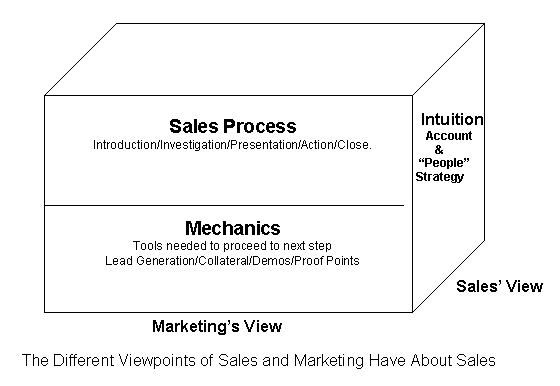|
|
| Home - Industry Article - Feb 05 Issue |
Why Sales and Marketing Are Always at Odds (and Sometimes War)! |
By Steve Martin, Author,
I consult with a lot of technology companies that are struggling with sales, and I have found that they all share something in common. Their sales and marketing efforts are at odds. Sometimes, they are even at war. The marketing team lectures the sales department, saying that if only sales would take their advice, its problems would be solved. Meanwhile, the sales department always says it needs something else from marketing. It is clamoring for a silver bullet that will convince the most ardent skeptic to buy.
The root cause of this situation is that sales and marketing have different views of the world. To the marketing department, selling is a series of steps that you guide a prospect through. These steps are based on the logic of purchasing the product, and the marketing team’s job is to provide the tools to move the prospect to the next step. Meanwhile, salespeople must work with the unpredictable part of the process: people. Their job is to formulate an account strategy based upon the people whom they are trying to sell to. They need intuition -- what to do and say in a particular competitive situation. The figure below illustrates this dilemma.

As a result, friction between the two areas develops. Salespeople feel they must translate theoretical arguments into a practical message while the marketing team believes the salespeople themselves are the problem. The solution to this problem is to define the intuition that sales needs. The first step is to understand the people involved in the sale: the different types of customer personalities, selfish interests that motivate the purchase, and languages the customers speak. Next, identify the circumstances of the sale: the competition, the players (e.g. the key decision maker’s authority and title) and the deal position (competitive, collaborative, or blind). Finally, a feedback loop for collecting win-loss information should be put into place.
True win-loss analysis is very important and unfortunately, it’s a lost art. Most companies never take the time to understand why they won a deal. They only examine losses. And they usually conduct the examination in one of two ways. In the “blame game,” the account team and various key departmental executives get together to hammer home their own personal agenda using the loss as a lightning rod. The sales team argues it needs a product enhancement or new marketing program while someone else may argue that sales is inept.
"True win-loss analysis is very important and unfortunately, it’s a lost art."
In the “cumulative dogpile,” the salesperson is put under a microscope and every account move is analyzed and criticized by management. It’s painful to witness and even worse to be the subject of one of these inquisitions. After the fog of war has lifted, it’s easy for the generals back at the corporate office to second-guess the battlefield actions and take potshots at their soldiers. Unfortunately, the cumulative dogpile and blame game impede the flow of critical information and dissuade the truth from being communicated.
The ongoing conflict between sales and marketing is a “pink elephant” at many companies. No one wants to talk about it until the problem becomes so obvious that it must be discussed. Even thought marketing “lectures” sales and sales “says” they need something else, they’re not communicating. However, the underlying argument is over power and control. When marketing tries to dictate sales strategy without listening to sales, the two will be at odds. When sales management doesn’t listen to salespeople, the truth is lost.
Ultimately, sales is a very personal battle between salespeople who fight one another in hand to hand combat. In the trenches, every move the salesperson makes is a matter of life or death. The best generals (from both sales and marketing) understand the intensity of the fight, share the same sense of urgency as the soldiers in the field, and visit the front lines often.
In roles ranging from salesperson to vice president, Steve Martin has been personally responsible for over a quarter of billion dollars of high technology sales while working for leading edge Silicon Valley companies over the past twenty years. His new book titled, Heavy Hitter Selling—How Successful Salespeople Use Language and Intuition to Persuade Customers to Buy, is the first book to truly explain the human nature of selling high technology. Visit www.heavyhitterselling.com for additional articles and information.
 

|
|


|

